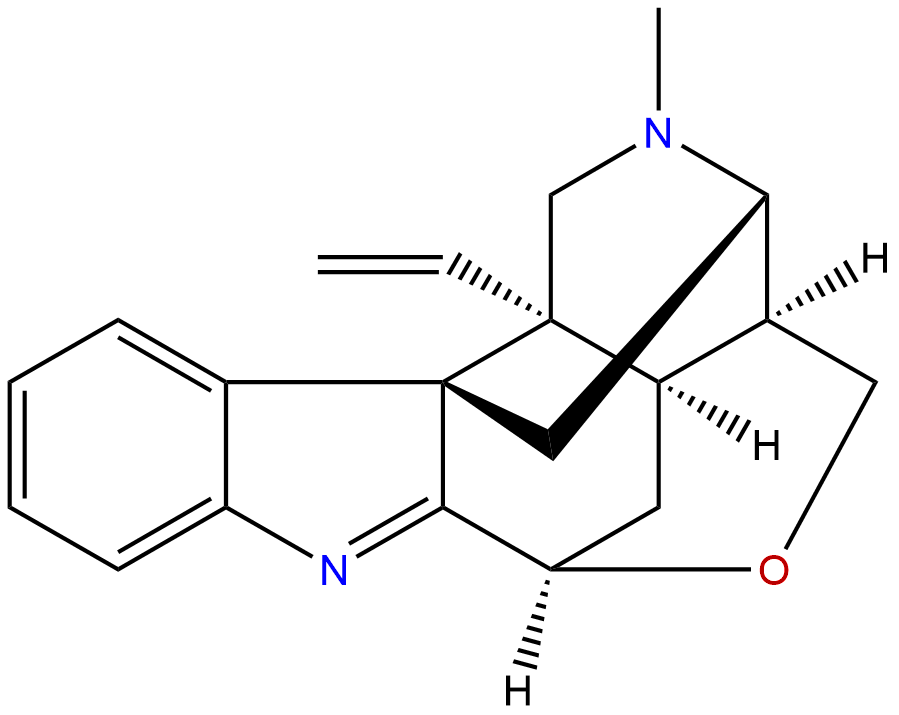
KoumineCAS No.:1358-76-5 |
||||||||||
 |
|
|
||||||||

| Catalogue No.: | BP0832 |
| Formula: | C20H22N2O |
| Mol Weight: | 306.409 |
| Botanical Source: | Gelsemium elegans |
Product name: Koumine
Synonym name:
Catalogue No.: BP0832
Cas No.: 1358-76-5
Formula: C20H22N2O
Mol Weight: 306.409
Botanical Source: Gelsemium elegans
Physical Description:
Type of Compound: Alkaloids
Purity: 95%~99%
Analysis Method: HPLC-DAD or/and HPLC-ELSD
Identification Method: Mass, NMR
Packing: Brown vial or HDPE plastic bottle
Storage: Store in a well closed container, protected from air and light. Put into refrigerate or freeze for long term storage.
Whenever possible, you should prepare and use solutions on the same day. However, if you need to make up stock solutions in advance, we recommend that you store the solution as aliquots in tightly sealed vials at -20℃. Generally, these will be useable for up to two weeks.
The product could be supplied from milligrams to grams
Inquire for bulk scale.
Description:
Koumine shows potent anti-tumor, anxiolytic, antistress, antipsoriatic, and analgesic activities, it also protects against the development of arthritis in Rheumatoid arthritis (RA) animal models.Koumine can induce apoptosis of LoVo cells in a time-dependent manner and inhibit the DNA synthesis in LoVo cells, thereby blocking the cell cycle from G1 to S phase.
References:
Cell Biochem Biophys. 2015 Jan 6.
Apoptotic Effect of Koumine on Human Breast Cancer Cells and the Mechanism Involved.
Koumine is an alkaloid separated from traditional Chinese herb Gelsemium elegans.
METHODS AND RESULTS:
In this study, anticancer activity and underlying mechanisms were investigated with an extract using human breast cancer cells. The survival rate was reduced in a concentration- and time-dependent manner as assessed by MTT assay. After incubation for 48 h, typical apoptotic morphological changes were observed by Hoechst 33258 dye assay. Flow cytometry result revealed that the treatment obviously induced G2/M arrest and apoptosis in MCF-7 cells. Furthermore, Western blotting demonstrated the down-regulation of protein expression of Bcl-2, whereas Bax and caspase-3 expressions were up-regulated.
CONCLUSIONS:
Therefore, we propose that Koumine has the potential to be a future breast cancer chemotherapeutic agent.
Di Yi Jun Yi Da Xue Xue Bao. 2005 May;25(5):562-4.
Effect of koumine on proliferation of murine CD4+ T cells purified by magnetic-activated cell sorting in vitro.
To assess the separation efficiency of magnetic-activated cell sorting in the purification of CD4+ T cells from murine spleen, and observe the effects of Koumine on the proliferation of the separated cells.
METHODS AND RESULTS:
CD4+ T cells were isolated from murine spleen by magnetic-activated cell sorting (MiniMACS). Fluorescence-activated cell sortering was employed to determine the purity of CD4+ T cells before and after the separation procedure followed by evaluation of the cell viability using trypan blue staining. Concanavalin A- (ConA, 5 microg/ml) or phytahematoagglutinin (PHA,1 mg/ml)-induced murine T cells were treated with different concentrations of Koumine (10-320 microg/ml), and their proliferation was determined by MTT colorimetry, and enzyme-linked immunosorbent assay was used to measure IL-2 level in the cell culture supernatant. The purity of CD4+ T cells reached (90.3+/-5.8)% after the purification with a cell viability of (94.9+/-3.6)%. Koumine (20-320 microg/ml) dose-dependently inhibited ConA- or PHA-induced proliferation of murine lymphocytes as compared with the controls (P<0.05). Koumine (20, 100, and 200 microg/ml) significantly decreased the level of IL-2 in comparison with the control group (P<0.05).
CONCLUSIONS:
CD4+ T cells of high purity can be obtained from murine spleen using MiniMACS without impairing the viability of the cells. Koumine significantly inhibits the proliferation of murine CD4+ T cells due to its immunosuppressive effect and inhibition of IL-2 secretion.
Pharmacol Biochem Behav. 2012 May;101(3):504-14.
Effects of koumine, an alkaloid of Gelsemium elegans Benth., on inflammatory and neuropathic pain models and possible mechanism with allopregnanolone.
Crude alkaloidal extraction from Gelsemium elegans Benth. produces analgesic property. However, its clinical utility has been obstructed by its narrow therapeutic index.
METHODS AND RESULTS:
Here, we investigated the potential of Koumine, a monomer of Gelsemium alkaloids, to reduce both inflammatory and neuropathic pain. Interestingly, allopregnanolone, a neurosteroid, appeared to mediate the reduction of neuropathic pain. The potential anti-inflammatory pain effects of Koumine were evaluated by acetic acid-, formalin- and complete Freund's adjuvant (CFA) -induced nociceptive behaviors in mice. Chronic constriction injury (CCI) and L5 spinal nerve ligation (L5 SNL), inducing thermal hyperalgesia and mechanical allodynia in rats, were used to test whether repeated treatment of Koumine ameliorated neuropathic pain. Finally, we explored if Koumine altered the level of neurosteroids in rat spinal cord of CCI neuropathy using liquid chromatography-tandem mass spectrometry. Koumine dose-dependently reduced the acetic acid-induced writhes and formalin-induced licking/biting time of Phase II in mice. Repeated administrations of Kouminealso dose-dependently reversed the CFA-, CCI- and L5 SNL-induced thermal hyperalgesia, as well as, CCI- and L5 SNL-induced mechanical allodynia in rats. The level of allopregnanolone, but not pregnenolone, in the L5-6 spinal cord was elevated by repeated treatment of Koumine in CCI-induced neuropathic rats.
CONCLUSIONS:
These results demonstrate that Koumine has a significant analgesic effect in rodent behavioral models of inflammatory and neuropathic pain, and that the reduction in neuropathic pain may be associated with the upregulation of allopregnanolone in the spinal cord.